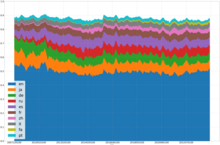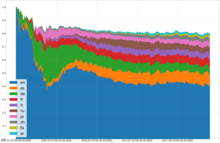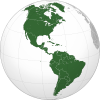Languages used on the Internet
Slightly over half of the homepages of the most visited websites on the World Wide Web are in English, with varying amounts of information available in many other languages.[1][2] Other top languages are Chinese, Spanish, Russian, Persian, French, German and Japanese.[1]
Of the more than 7,000 existing languages, only a few hundred are recognized as being in use for Web pages on the World Wide Web.[3]
Languages used[edit]
There is debate over the most-used languages on the Internet. A 2009 UNESCO report monitoring the languages of websites for 12 years, from 1996 to 2008, found a steady year-on-year decline in the percentage of webpages in English, from 75 percent in 1998 to 45 percent in 2005.[2] The authors found that English remained at 45 percent of content for 2005 to the end of the study but believe this was due to the bias of search engines indexing more English-language content rather than a true stabilization of the percentage of content in English on the World Wide Web.[2]
The number of non-English web pages is rapidly expanding. The use of English online increased by around 281 percent from 2001 to 2011, a lower rate of growth than that of Spanish (743 percent), Chinese (1,277 percent), Russian (1,826 percent) or Arabic (2,501 percent) over the same period.[4]
According to a 2000 study, the international auxiliary language Esperanto ranked 40 out of all languages in search engine queries, also ranking 27 out of all languages that rely on the Latin script.[5]
Usage statistics of content languages for websites[edit]
W3Techs estimated percentages of the top 10 million websites on the World Wide Web using various content languages as of 13 July 2024:[1]
| Rank | Language | 16 May 2023 | 13 July 2024 |
|---|---|---|---|
| 1 | English | 55.5% | 49.7% |
| 2 | Spanish | 5.0% | 5.9% |
| 3 | Russian | 4.9% | 4.1% |
| 4 | German | 4.3% | 5.4% |
| 5 | French | 4.4% | 4.3% |
| 6 | Japanese | 3.7% | 4.9% |
| 7 | Portuguese | 2.4% | 3.7% |
| 8 | Turkish | 2.3% | 1.9% |
| 9 | Italian | 1.9% | 2.6% |
| 10 | Persian | 1.8% | 1.3% |
| 11 | Dutch | 1.5% | 2.1% |
| 12 | Polish | 1.4% | 1.8% |
| 13 | Chinese | 1.4% | 1.2% |
| 14 | Vietnamese | 1.3% | 1.1% |
| 15 | Indonesian | 0.7% | 1.1% |
| 16 | Czech | 0.7% | 0.9% |
| 17 | Korean | 0.7% | 0.8% |
| 18 | Ukrainian | 0.6% | 0.6% |
| 19 | Arabic | 0.7% | 0.5% |
| 20 | Greek | 0.5% | 0.5% |
| 21 | Hebrew | 0.5% | 0.4% |
| 22 | Swedish | 0.5% | 0.5% |
| 23 | Romanian | 0.4% | 0.5% |
| 24 | Hungarian | 0.4% | 0.6% |
| 25 | Thai | 0.4% | 0.4% |
| 26 | Danish | 0.3% | 0.4% |
| 27 | Slovak | 0.3% | 0.4% |
| 28 | Finnish | 0.3% | 0.4% |
| 30 | Serbian | 0.3% | 0.2% |
| 31 | Norwegian | 0.1% | 0.1% |
| 29 | Bulgarian | 0.2% | 0.3% |
| 32 | Lithuanian | 0.1% | 0.2% |
| 33 | Slovenian | 0.1% | 0.1% |
| 34 | Catalan | 0.1% | 0.1% |
| 35 | Estonian | 0.1% | 0.1% |
| 36 | Latvian | 0.1% | 0.1% |
| 37 | Bokmål | 0.1% | 0.2% |
| 38 | Croatian | 0.2% | 0.2% |
All other languages are used in less than 0.1% of websites. Even including all languages, percentages may not sum to 100% because some websites contain multiple content languages.
The figures from the W3Techs study are based on the one million most visited websites (i.e., approximately 0.27 percent of all websites according to December 2011 figures) as ranked by Alexa.com, and language is identified using only the home page of the sites in most cases (e.g., all of Wikipedia is based on the language detection of http://www.wikipedia.org).[6] As a consequence, the figures show a significantly higher percentage for many languages (especially for English) as compared to the figures for all websites.[7] For all websites, estimates are between 20 and 50% for English.[8][2][9][10]
Most Used Scripts On The Internet[edit]
| # | Script | % |
|---|---|---|
| 1 | Latin | 84.7% |
| 2 | Cyrillic | 5.1% |
| 3 | Kana/Kanji | 4.9% |
| 4 | Arabic | 1.9% |
| 5 | Hanzi | 1.3% |
| 6 | Hangul | 0.8% |
| 7 | Greek | 0.5% |
| 8 | Hebrew | 0.4% |
| 9 | Thai | 0.4% |
Content languages on YouTube[edit]
Of the top 250 YouTube channels, 66% of the content is in English, 15% in Spanish, 7% in Portuguese, 5% in Hindi, 2% in Korean, while other languages make up 5%,[11] although other sources point to different percentages.[12][better source needed] YouTube is available in over 80 languages with more than a hundred different local versions.[13] Of those popular YouTube channels that posted a video in the first week of 2019, just over half contained some content in a language other than English.[14]
Internet users by language[edit]
InternetWorldStats estimates of the number of Internet users by language as of March 31, 2020:[15][16][17][18][19][20][21]
| Rank | Language | Internet users |
Percentage |
|---|---|---|---|
| 1 | English | 1,186,451,052 | 25.9% |
| 2 | Chinese | 888,453,068 | 19.4% |
| 3 | Spanish | 363,684,593 | 7.9% |
| 4 | Arabic | 237,418,349 | 5.2% |
| 5 | Indonesian | 198,029,815 | 4.3% |
| 6 | Portuguese | 171,750,818 | 3.7% |
| 7 | French | 144,695,288 | 3.3 % |
| 8 | Japanese | 118,626,672 | 2.6% |
| 9 | Russian | 116,353,942 | 2.5% |
| 10 | German | 92,525,427 | 2.0% |
| 1–10 | Top 10 languages | 3,525,027,347 | 76.9% |
| – | Others | 1,060,551,371 | 23.1% |
| Total | 4,585,578,718 | 100% |
Wikipedia page views by language[edit]



Wikimedia Statistics gives the number of page views of each edition of Wikipedia by language.[22]
| Rank | Language | Daily page views (average during the last year with "Agent"="User" on 4 January 2021) |
|---|---|---|
| 1 | English | 257,705,129 |
| 2 | Japanese | 37,286,466 |
| 3 | Spanish | 37,018,505 |
| 4 | German | 30,844,175 |
| 5 | Russian | 26,358,126 |
| 6 | French | 24,392,611 |
| 7 | Italian | 18,622,198 |
| 8 | Chinese | 13,371,571 |
| 9 | Portuguese | 11,506,680 |
| 10 | Polish | 8,810,420 |
| 11 | Arabic | 7,333,102 |
| 12 | Persian | 5,672,829 |
| 13 | Indonesian | 5,385,401 |
| 14 | Dutch | 4,935,611 |
| 15 | Turkish | 3,382,454 |
See also[edit]
- Computer technology for developing areas – The donation of technology to developing areas
- English in computing – English as lingua franca of programming and computer science
- Global digital divide – Global disparities in regards to access to computing and information resources
- Great Firewall – Chinese internet regulations
- Internationalization and localization – Process of making software accessible to people in different areas of the world
- Language localisation – Translating the text in a program to a different tongue
- Website localization – Website adaptation process
- Internet in China
- Internet in Russia – Overview of the Internet in Russia
- Internet censorship and surveillance by country
- List of countries by number of broadband Internet subscriptions
- List of countries by number of Internet hosts
- List of countries by number of Internet users
- Multilingualism – Use of multiple languages
- Rural internet – Internet service in rural areas
- Unicode – Character encoding standard
References[edit]
- ^ a b c "Usage statistics of content languages for websites". archive.fo. Archived from the original on 12 November 2021. Retrieved 12 November 2021.
- ^ a b c d Pimienta, Daniel; Prado, Daniel; Blanco, Álvaro (2009). "Twelve years of measuring linguistic diversity in the Internet: balance and perspectives". United Nations Educational, Scientific and Cultural Organization. Archived from the original on 3 April 2015. Retrieved 24 March 2015.
- ^ "What continents have the most indigenous languages?". Ethnologue. 3 May 2019. Archived from the original on 27 December 2019. Retrieved 27 December 2019.
- ^ Rotaru, Alexandru. "The foreign language Internet is good for business". Archived from the original on 7 April 2013. Retrieved 21 June 2011.
- ^ Grefenstette, Gregory; Nioche, Julien. "Estimation of English and non-English Language Use on the WWW Archived 10 April 2018 at the Wayback Machine". Proceedings of RIAO'2000, "Content-Based Multimedia Information Access", Paris, April 12–14, 2000, pp. 237-246.
- ^ "Technologies Overview". W3Techs. Retrieved 24 March 2015.
- ^ An alternative approach to produce indicators of languages in the Internet Archived 31 August 2017 at the Wayback Machine Pimienta, Daniel, June 2017
- ^ Vannini, Laurent; Le Crosnier, Hervé (March 2012). "NET.LANG: Towards a multilingual cyberspace". Net.lang: réussir le cyberespace multilingue. Caen: C&F éd. ISBN 978-2-915825-08-4. Archived from the original on 4 March 2016 – via Maaya Network.
- ^ Pimienta, Daniel (2022). "Resource: Indicators on the Presence of Languages in Internet". Proceedings of the 1st Annual Meeting of the ELRA/ISCA Special Interest Group on Under-Resourced Languages. Marseille, France: European Language Resources Association: 83–91.
- ^ Pimienta, Daniel; Blanco, Álvaro; de Oliveira, Gilvan Müller (2023). "The method behind the unprecedented production of indicators of the presence of languages in the Internet". Frontiers in Research Metrics and Analytics. 8. doi:10.3389/frma.2023.1149347. ISSN 2504-0537. PMC 10233101. PMID 37273659.
- ^ Yang, Brian (2019). "6 Common Features Of Top 250 YouTube Channels". Twinword, Inc. Retrieved 19 September 2021.
- ^ Expert, Alan Spicer-YouTube Certified (24 November 2020). "Top Languages on YouTube [All The Stats!] [Dominate YouTube with Multiple Languages]". Alan Spicer - YouTube Certified Expert. Retrieved 9 April 2023.
- ^ GMI Blogger (18 April 2022). "YouTube User Statistics 2022". Global Media Insight - Dubai Digital Interactive Agency. Archived from the original on 27 April 2022. Retrieved 2 May 2022.
- ^ van Kessel, Patrick; Toor, Skye; Smith, Aaron (25 July 2019). "Popular YouTube channels produced a vast amount of content, much of it in languages other than English". Pew Research Center. Retrieved 2 May 2022.
- ^ "Top Ten Internet Languages in The World - Internet Statistics". web.archive.org. 7 September 2019. Retrieved 4 July 2024.
- ^ "Internet: most common languages online by users 2017". Statista. Retrieved 4 July 2024.
- ^ Schäferhoff, Nick (24 July 2023). "Most Used Languages on the Internet (Which to Add to Your Site?)". TranslatePress. Retrieved 4 July 2024.
- ^ Berta, Natalie (23 May 2022). "What Are the Most Used Languages on the Internet & Why?". MosaLingua. Retrieved 4 July 2024.
- ^ Admin (26 May 2022). "Top 10 Languages Used On the Internet And Why?". Tridindia. Retrieved 4 July 2024.
- ^ "10 Most Common Languages Used On The Internet For 2024". www.marstranslation.com. Retrieved 4 July 2024.
- ^ "Langues dans Internet". www.axl.cefan.ulaval.ca. Retrieved 4 July 2024.
- ^ List of Wikipedias/Table2 Archived 17 January 2021 at the Wayback Machine, Wikimedia, read on January 4, 2021
External links[edit]
- Internet World Users by Language, Internet World Stats.
- "Estimation of English and non-English Language Use on the WWW", Gregory Grefenstette and Julien Nioche, in Proceedings of RIAO'2000, Content-Based Multimedia Information Access, Paris, 12–14 April 2000, pp. 237–246.
- World GDP by Language 1975–2002, Mark Davis, Unicode Technical Note #13 (2003).
- "Writing the Web’s Future in Many Languages", Daniel Sorid, New York Times, 30 December 2008.
- Statistical Survey Report on Internet Usage in China, China Internet Network Information Center (2009), English translation.
- List of CNNIC statistical reports, China Internet Network Information Center (1997-2010).
- Measuring Linguistic Diversity on the Internet, UNESCO (2006).
- Twelve years of measuring linguistic diversity in the Internet, UNESCO (2009).
- Language Observatory, Japan Science and Technology Agency (2012).
- Observatory of linguistic and cultural diversity on the Internet

